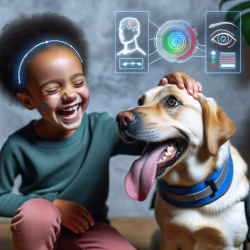Introduction
Autism Spectrum Disorder (ASD) presents unique challenges, particularly in social interaction and communication. A recent pilot study, "Emotion Facial Processing in Children With Autism Spectrum Disorder: A Pilot Study of the Impact of Service Dogs," explores an innovative approach to enhancing these skills in children with ASD through the use of service dogs. This blog delves into the study's findings and their implications for practitioners seeking data-driven strategies to support children with ASD.
The Study: Key Findings
The study compared two groups of children with ASD: those with a service dog and those without. Using a facial expression recognition task and eye-tracking technology, researchers observed how children processed facial expressions. While both groups showed similar accuracy and reaction times, children with service dogs demonstrated more efficient visual exploration strategies. They focused more on relevant facial features, such as the mouth and eyes, depending on the emotion displayed.
Implications for Practitioners
These findings suggest that service dogs can play a significant role in developing facial processing skills in children with ASD. Practitioners can consider incorporating service dogs into therapeutic settings to promote better social and emotional outcomes. The differentiated scanning strategies observed in children with service dogs align more closely with typical patterns seen in neurotypical individuals, indicating a potential for service dogs to bridge gaps in social processing.
Encouraging Further Research
While this study provides promising insights, further research with larger sample sizes is necessary to validate these findings. Practitioners are encouraged to explore additional variables, such as the impact of different types of pets or the severity of ASD symptoms, to understand the broader implications of animal-assisted interventions.
Conclusion
The integration of service dogs into the daily lives of children with ASD may offer more than companionship; it can be a catalyst for improved social interaction and emotional processing. As we continue to seek innovative, evidence-based approaches to support children with ASD, the role of service dogs warrants further exploration and consideration.
To read the original research paper, please follow this link: Emotion Facial Processing in Children With Autism Spectrum Disorder: A Pilot Study of the Impact of Service Dogs.










